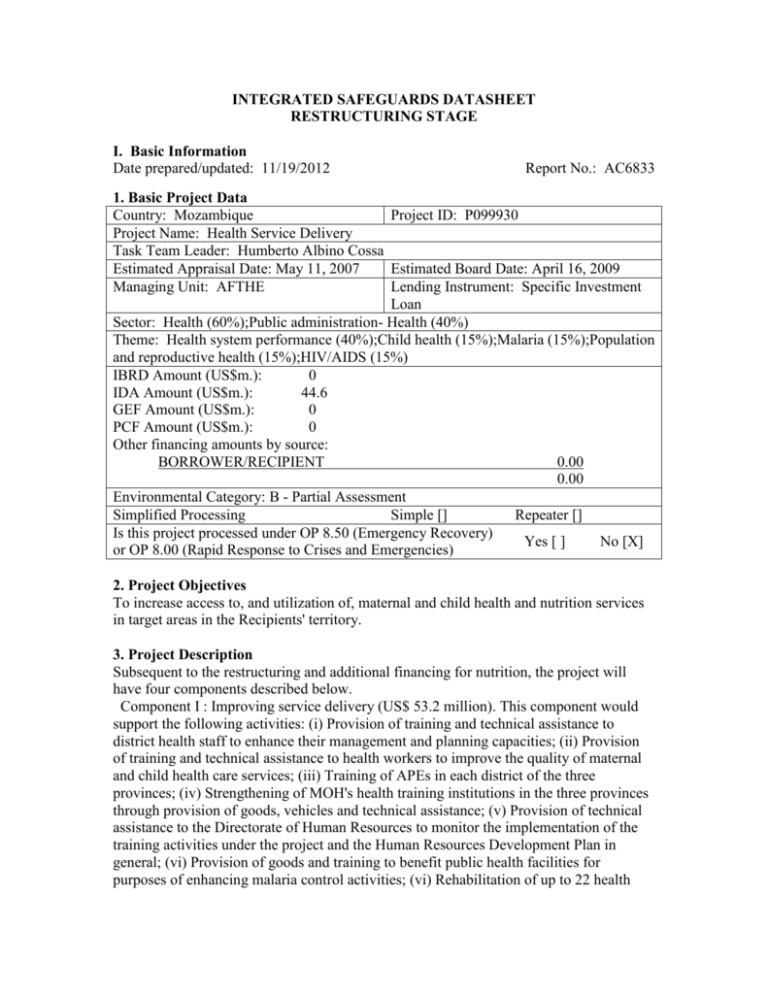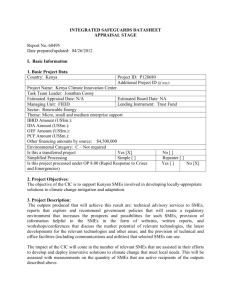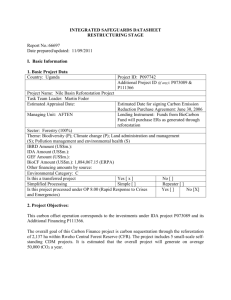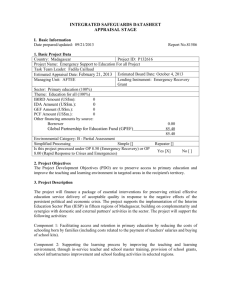integrated safeguards datasheet - Documents & Reports
advertisement

INTEGRATED SAFEGUARDS DATASHEET RESTRUCTURING STAGE I. Basic Information Date prepared/updated: 11/19/2012 Report No.: AC6833 1. Basic Project Data Country: Mozambique Project ID: P099930 Project Name: Health Service Delivery Task Team Leader: Humberto Albino Cossa Estimated Appraisal Date: May 11, 2007 Estimated Board Date: April 16, 2009 Managing Unit: AFTHE Lending Instrument: Specific Investment Loan Sector: Health (60%);Public administration- Health (40%) Theme: Health system performance (40%);Child health (15%);Malaria (15%);Population and reproductive health (15%);HIV/AIDS (15%) IBRD Amount (US$m.): 0 IDA Amount (US$m.): 44.6 GEF Amount (US$m.): 0 PCF Amount (US$m.): 0 Other financing amounts by source: BORROWER/RECIPIENT 0.00 0.00 Environmental Category: B - Partial Assessment Simplified Processing Simple [] Repeater [] Is this project processed under OP 8.50 (Emergency Recovery) Yes [ ] No [X] or OP 8.00 (Rapid Response to Crises and Emergencies) 2. Project Objectives To increase access to, and utilization of, maternal and child health and nutrition services in target areas in the Recipients' territory. 3. Project Description Subsequent to the restructuring and additional financing for nutrition, the project will have four components described below. Component I : Improving service delivery (US$ 53.2 million). This component would support the following activities: (i) Provision of training and technical assistance to district health staff to enhance their management and planning capacities; (ii) Provision of training and technical assistance to health workers to improve the quality of maternal and child health care services; (iii) Training of APEs in each district of the three provinces; (iv) Strengthening of MOH's health training institutions in the three provinces through provision of goods, vehicles and technical assistance; (v) Provision of technical assistance to the Directorate of Human Resources to monitor the implementation of the training activities under the project and the Human Resources Development Plan in general; (vi) Provision of goods and training to benefit public health facilities for purposes of enhancing malaria control activities; (vi) Rehabilitation of up to 22 health facilities; (vii) Construction of up to eighteen (18) health centers type II and two (2) houses for MOH health personnel for each health facility newly built; and (viii) strengthening of MOH's Health Care Waste Management Plan (HCWM) implementation in the three provinces through provision of goods, training of health staff, and better supervision of HCWM in health facilities. The new health centers are designed to provide simply primary healthcare services, including vaccinations, pre-natal care, routine births, treatment of simple wounds and distribution of medicines to rural beneficiary populations estimated between 7,500 and 20,000 persons. Subcomponent Ia: Scaling up of Nutrition Activities (US$ 27.0 million). This subcomponent will primarily support community based nutrition (CBN) services implementation in the three Northern provinces through contractual arrangements between the MOH and eligible Non Government Organizations (NGOs). The specific nutrition interventions will include: (i) Growth monitoring and promotion every two months, including referral services for the treatment of severe and moderate acute malnourished children; (ii) Promotion of exclusive breastfeeding and appropriate complementary feeding, including cooking demonstration, use of micronutrient powder (MNP) and deworming for children; (iii) Early identification and mobilization of pregnant women for ante-natal care services, dietary counseling, including provision of IFA tablets, and deworming for all pregnant women; (iv) Adapted health and nutrition counselling for adolescent girls aged 11-19 as well as the provision of IFA tablets and deworming; and (v) Education on safe water, hygiene, sanitation and referral services for infectious disease control, including immunization. Dispersible zinc tablets and Oral Rehydration Salt (ORS) will be distributed to treat diarrhea among children. Component II: Boosting of national malaria control program (US$15.2 million). This component would support the following activities: (i) Strengthening the malaria management program; (ii) Acquisition of essential drugs, and rapid-diagnostic test kits, microscopes, computer equipment and vehicles; (iii) Design and implementation of a national training program on malaria monitoring & evaluation; (iv) Strengthening vector control through the provision of training, technical assistance and good. Component III: Strategic Planning and Capacity Building (US$ 7.5 million). This component would support the following activities: (i) Developing the next five year Health Sector Strategic Plan which will include, inter alia, preparation of a new health care finance strategy, implementation of a service availability mapping survey, and operational research in human resources; (ii) Preparing the additional financing for nutrition (Project number P125477); (iii) Build capacity of health staff to enhance nutrition program contract implementation and monitoring and evaluation at central, provincial, district, and facility levels through provision of pre- and in-service training; (iv) Operational research in the area of nutrition to generate knowledge and foster innovation; (v) Strengthening the supply chain management, and (vi) Provision of training to health staff at provincial level to enhance their financial management, and monitoring and evaluation knowledge. Component IV: Project Management and Operating Costs (US$1.5 million). This component would support the following activities: (i) Operating cost necessary to implement project activities such as fuel, utilities, vehicle maintenance, per diems for Parts A, B, C, and D of the Project; (ii) Salaries of Community health workers APEs for the remaining period of the project and non monetary incentive to other community health agents; (iii) Establishment of a decentralized regional unit at provincial level to support data processing, filing of key strategic documents and studies, and support relevant health research; and (iii) Distribution costs, which are defined as: a) temporary labor (seasonal workers contracted to provide additional labor when necessary); (b) printing of forms; (c) warehouse supplies; (d) temporary warehouse rental; (e) basic repair and maintenance costs of materials and handling equipment; and (f) maintenance and fuel costs for vehicles used in the distribution of health commodities; and () Financing of operating costs. In addition to the rehabilitation of up to 22 existing health centers, under the restructured project, up to 18 new type II rural health centers will be constructed. 4. Project Location and salient physical characteristics relevant to the safeguard analysis The program would be implemented in the three Northern provinces of Cabo Delgado, Nampula, and Niassa. Construction of new health centers will take place close to existing settlements within rural areas of these provinces. Land use in the areas where the health centers will be built is predominantly extensive subsistence agriculture. Some protected areas and biologically important natural habitats do occur in the three provinces, but not in the localities where the health centers will be built. 5. Environmental and Social Safeguards Specialists Mr Cheikh A. T. Sagna (AFTCS) Mr Stephen Ling (AFTN3) 6. Safeguard Policies Triggered Environmental Assessment (OP/BP 4.01) Natural Habitats (OP/BP 4.04) Forests (OP/BP 4.36) Pest Management (OP 4.09) Physical Cultural Resources (OP/BP 4.11) Indigenous Peoples (OP/BP 4.10) Involuntary Resettlement (OP/BP 4.12) Safety of Dams (OP/BP 4.37) Projects on International Waterways (OP/BP 7.50) Projects in Disputed Areas (OP/BP 7.60) Yes X No X X X X X X X X X II. Key Safeguard Policy Issues and Their Management A. Summary of Key Safeguard Issues 1. Describe any safeguard issues and impacts associated with the proposed project. Identify and describe any potential large scale, significant and/or irreversible impacts: The HSDP is classified as Category B (a partial environmental and social analysis is considered appropriate to address specific social and environmental issues) for three reasons: , (i) the program would involve the provision of medical supplies, and therefore will generate healthcare waste, (ii) construction of type 2or rehabilitation of rural health centers involves small-scale civil works which could have localized and site specific environmental and/or social impacts, and will also lead to generation of relative amounts of healthcare waste, and (iii) the program would involve some aspects of vector control under its malaria control component, including provision of bed nets, and training and monitoring activities in relation to spraying program. The program will not finance any pesticides or spraying equipment as indoor residual spraying is financed under the ongoing President's Malaria Initiative, executed by the United States Agency for International Development (USAID). No large-scale, significant or irreversible impacts are anticipated. 2. Describe any potential indirect and/or long term impacts due to anticipated future activities in the project area: Not anticipated. 3. Describe any project alternatives (if relevant) considered to help avoid or minimize adverse impacts. Completion of the project without the inclusion of civil works for construction or rehabilitation of rural health centers was considered; but these are extremely high priorities for the effective provision of primary health care in the targeted provinces, and as the associated site specific potential environmental and social impacts are minor and easily manageable, it was decided to proceed with their inclusion. 4. Describe measures taken by the borrower to address safeguard policy issues. Provide an assessment of borrower capacity to plan and implement the measures described. 1) Health Care Waste Management Plan (HCWMP). The Healthcare Waste Management Plan developed under the previous HIV/AIDS Response Project will be used and monitored. Selected activities of the national action plan will be supported under this project to improve implementation of the HCWMP. Emphasis will be placed on the targeted three provinces under this project. National regulations have already been strengthened under this HCWMP, awareness of the issues is significantly increased and routine implementation and monitoring systems are gradually being upgraded. Following the project Mid-Term Re view, however, it was decided that the restructuring should provide additional project resources to further accelerate the implementation of national legislation developed under the HCWMP specifically within the three project provinces. 2) Environment and Social Management Plan (ESMP) for construction or renovation of rural health centers. Construction of type II rural health centers conforms to a standard national design. As (i) the nature and scale of the construction activities are therefore well-characterized and pose minimal risks, and (ii) strict siting criteria have been established to prevent the location of new centers in environmentally and/or socially sensitive areas, Borrower developed an ESMP that provides a set of standard social and environmental mitigation measures for implementing civil works. This is consistent with both national ESIA regulations as well as World Bank OP/BP 4.01 policy, which require compliance with established applicable regulations for this type of construction. The ESMP specifies the health care waste disposal facilities to be provided in the new health centers, and provides guidance as to how health care waste will be managed in line with the existing HCWMP and national regulations. The project will recruit a construction supervision consultant to assure the quality of civil works and compliance with the ESMP. Implementation of health care waste management systems in new or renovated health centers will be supported and monitored through the broader project support to improving healthcare waste management under component 1, and in accordance with the existing HCWMP. 3) Vector Management Plan (VMP). Although vector management activities supported by the project are limited to provision of mosquito bed nets, and some training and monitoring activities, the project formally adopted the Vector Management Plan already developed for the national indoor residual spraying (IRS) program being implemented by MISAU. An international development group (RTI International) was selected to elaborate an environmental assessment for all indoor residual spraying operations. The EA documents include a programmatic environmental assessment for malaria integrated vector management programs, an assessment for IRS in Mozambique and a safe use action plan for the use of DDT, bendiocarb and lambda-cyhalothrin. The environmental assessment for indoor residual spraying was prepared to address the identified issues surrounding IRS operations. This IRS program is part of the President's Malaria Initiative (PMI) in Africa, working with the World Bank, the Global Fund, and other members of the Roll Back Malaria Partnership. Within the USAID/Mozambique Integrated Health Sector (HIS) Strategic Objective Agreement, an initial Environmental Assessment (2005) identified the distribution, use and re-treatment of Insecticide Treated Nets (ITNs) and Long-Lasting Insecticidal Nets (LLINs) as a major intervention for malaria control. This intervention came with a number of conditions, listed in the Safer Use Action Plan, and based on recommendations from the Programmatic Environmental Assessment for InsecticideTreated Materials in USAID Activities in Sub-Saharan Africa. Under the PMI, USAID proposes to help the government of Mozambique implement an Indoor Residual Spraying (IRS) program for malaria vector control. Mozambique is characterized by perennial malaria transmission, and IRS would be used to reduce malaria incidence in the seasons of highest transmission. This IRS program will be part of other vector management measures supported and implemented by the MOH that include the distribution and use of bed nets. Because of the potential environmental impact of the pesticides proposed for use, DDT, bendiocarb and lambda-cyhalothrin, this environmental assessment identifies the mitigating measures to minimize potential impacts while achieving a significant reduction in malaria incidence. The MOH and the Ministry for Coordination of Environmental Affairs (MICOA) will implement the risk reduction actions outlined in the environmental assessment (EA) and vector management plan and re-examine the need for DDT while considering other chemical options for IRS operations to achieve best vector control. The Safer Use Action Plan is to be implemented with relevant partners as a management tool for dealing with and accomplishing the objectives. IRS supervisors, team leaders, and spray operators will be trained according to WHO guidelines as well as Ministry of Agriculture standards. Insecticide poisoning management training will be provided to health workers. Pyrethroid, DDT and carbamate poisoning treatment medications and antidotes will be provided to trained health workers by the MOH. Insecticide storage facility storekeepers will also be trained on proper store management. Occupational exposure to insecticides will be minimized through personal protective equipment (according to WHO guidelines). A public awareness campaign will educate home owners on their roles and responsibilities during the spray campaign to avoid exposure, and supervisors will remind residents of these responsibilities during spray campaigns. Environmental contamination will be kept to a minimum through strict auditing, handling, washing, and disposal practices. Each insecticide sachet will be strictly accounted for, contaminated waste-water and rinse-water will be re-used in subsequent days of spraying (progressive and pressure rinsing). Empty DDT sachets will be collected by the MOH and returned to the supplier (if possible) or disposed of in an environmentally safe manner. The HSDP team will actively monitor ongoing activities for compliance with the requirements and recommendations in this assessment, and modify or end activities that are not in compliance. Project team will actively monitor ongoing activities for compliance with the requirements and recommendations in this assessment, and modify or end activities that are not in compliance. If additional activities are added to this program that are not described in the EA/VMP document, an amended EA/VMP will be prepared prior to implementation of those activities. This includes any commodities, pesticide products being considered under the program but not covered in the present EA/VMP. 5. Identify the key stakeholders and describe the mechanisms for consultation and disclosure on safeguard policies, with an emphasis on potentially affected people. The HCWMP was consulted upon and disclosed under the earlier HIV/AIDS Response Project, and re-disclosed on May 25, 2007 under the present project. The VMP was reviewed by the Bank and circulated for public consultation on May 25, 2007. For the construction of new rural health centers, proposed sites have been identified jointly with local beneficiaries, and extensive discussions have been held with local communities as part of the process of obtaining DUATs (Government issued legal land title (DUAT) to certify that the identified pieces of lands in the following districts: Palma, Mocímboa da Praia, Mueda, Ancuabe, Balama and Chiúre in Cabo Delgado Province; Malema, Ribaué, Lalaua, Mugovolas, Memba and Nacarôa in Nampula Province; and Metarica, Cuamba, Mandimba, Lago Niassa, Majune and Marrupa in Niassa province are each free of any claim and fit for the proposed development activities). In light of the above, the Bank as ascertained that OP/BP 4.12 policy will not be triggered; nevertheless, should, for any reason the selection of sites needs to be adjusted, the same process will be followed, as described in the ESMP, to ensure that local communities are consulted and that the given land is free of any potential claim that could lead to either physical resettlement or loss of asset that would require compensation of project affected persons. The draft ESMP was reviewed and cleared by the Bank and MICOA, a national-level stakeholders consultation meeting was held on October 30, 2012 in Maputo; and the ESMF was disclosed both on the MISAU website and in the World Bank InfoShop on November 16, 2012. B. Disclosure Requirements Date Environmental Assessment/Audit/Management Plan/Other: Was the document disclosed prior to appraisal? N/A Date of receipt by the Bank 11/12/2012 Date of "in-country" disclosure 11/16/2012 Date of submission to InfoShop 11/16/2012 For category A projects, date of distributing the Executive Summary of the EA to the Executive Directors Resettlement Action Plan/Framework/Policy Process: Was the document disclosed prior to appraisal? Date of receipt by the Bank Date of "in-country" disclosure Date of submission to InfoShop Indigenous Peoples Plan/Planning Framework: Was the document disclosed prior to appraisal? Date of receipt by the Bank Date of "in-country" disclosure Date of submission to InfoShop Pest Management Plan: Was the document disclosed prior to appraisal? N/A Date of receipt by the Bank N/A Date of "in-country" disclosure N/A Date of submission to InfoShop N/A * If the project triggers the Pest Management and/or Physical Cultural Resources, the respective issues are to be addressed and disclosed as part of the Environmental Assessment/Audit/or EMP. If in-country disclosure of any of the above documents is not expected, please explain why: C. Compliance Monitoring Indicators at the Corporate Level (to be filled in when the ISDS is finalized by the project decision meeting) OP/BP/GP 4.01 - Environment Assessment Does the project require a stand-alone EA (including EMP) report? If yes, then did the Regional Environment Unit or Sector Manager (SM) review and approve the EA report? Are the cost and the accountabilities for the EMP incorporated in the credit/loan? OP 4.09 - Pest Management Does the EA adequately address the pest management issues? Is a separate PMP required? If yes, has the PMP been reviewed and approved by a safeguards specialist or SM? Are PMP requirements included in project design? If yes, does the project team include a Pest Management Specialist? The World Bank Policy on Disclosure of Information Have relevant safeguard policies documents been sent to the World Bank's Infoshop? Have relevant documents been disclosed in-country in a public place in a form and language that are understandable and accessible to project-affected groups and local NGOs? All Safeguard Policies Have satisfactory calendar, budget and clear institutional responsibilities been prepared for the implementation of measures related to safeguard policies? Have costs related to safeguard policy measures been included in the project cost? Does the Monitoring and Evaluation system of the project include the monitoring of safeguard impacts and measures related to safeguard policies? Have satisfactory implementation arrangements been agreed with the borrower and the same been adequately reflected in the project legal documents? Yes Yes Yes Yes Yes Yes Yes Yes Yes Yes Yes Yes D. Approvals Signed and submitted by: Task Team Leader: Environmental Specialist: Social Development Specialist Additional Environmental and/or Social Development Specialist(s): Name Mr Humberto Albino Cossa Mr Stephen Ling Mr Cheikh A. T. Sagna Approved by: Sector Manager: Comments: Mr Olusoji O. Adeyi Date 11/16/2012 11/02/2012 10/28/2012







